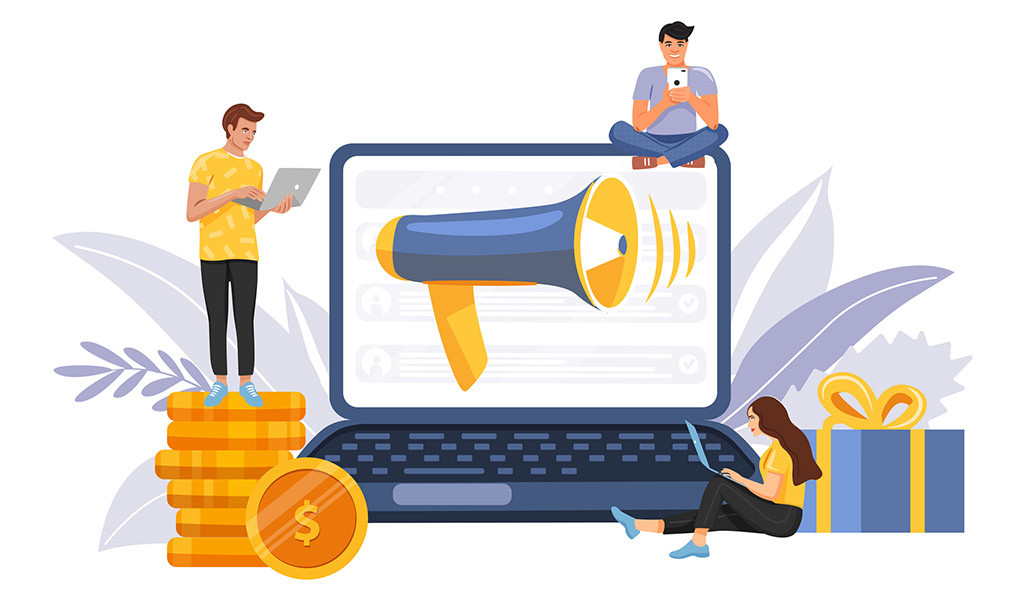Loyalty is what keeps your customers coming back to you and keeps them away from your competitors. Building up customer loyalty doesn’t happen by accident. It’s something you have to dedicate time, energy, and budget to if you want to succeed at it. Although building your customer loyalty programs take some effort on your part, they are more than worth it, but why? Firstly, it’s much more costly to acquire a new customer than retain an existing one, 6 to 7 times more costly. Secondly, you can vastly increase your profits by focusing on customer retention. One study found that by increasing your customer retention rate by as little as 5%, you can increase your profits by up to a huge 95%.
Today we’re going to look at everything you need to know about customer rewards programs (otherwise known as customer loyalty programs). Let’s get started.
Types Of Loyalty Programs
Customer Loyalty Punch Cards
You probably have one of these yourself floating around in your wallet or purse. Customer loyalty punch cards are usually the same size as a business card (3.5 x 2 inches) and will have a series of areas you can stamp when the customer hits purchasing milestones. This can either be a set number of products purchased or a total dollar amount. These are really common in coffee shops where customers can buy 9 coffees and get the 10th free, or something similar. However, they can work for other businesses too. For example, let’s say you sell printer ink. You may offer to give the customer a free ink cartridge when they spend $300 with your company. The customer can earn this reward by completing 5 x $60 purchases that are recorded on their punch card.
Customer loyalty punch cards work because they play on some pretty basic psychology. Customers are more likely to frequent a business where they can get free stuff.
Some businesses have taken to using virtual customer loyalty punch cards to great success. The issue with physical punch cards is that they are hard to track and analyze. How do you know that your reward program is working? Is it cost-effective? Could you encourage more customers to frequent your business if you tweak the punch card a little bit? These are all questions that are near impossible to answer with physical punch cards because once they leave your company, you no longer have control over them.
With digital punch cards, you can track and apply rewards automatically and analyze their success. You can see exactly how many customers use the program and how frequently they purchase from you. You can also make tweaks to the program and run it again to see if your milestones are successful at converting infrequent buyers to frequent buyers. If we go back to our printer ink example, you may decide to start the program with $60 milestones but then realize that this is actually too big of a milestone. You may decide to lower it to $50 and find that many more customers are tempted to use your company again.
Below are the main benefits of customer loyalty punch cards.
- They are very quick and easy to set up.
- They are highly customizable.
- It’s a low-cost option for the business. You might be giving away free products but think of all the sales that wouldn’t have happened without the program.
- It increases sales. A 2016 study found that customers who are members of a customer rewards program spend on average 12 to 18% more than non-members.

Loyalty Points System
A loyalty points program is where you create your own form of currency that customers can build up and spend at your company. A common example of this is frequent flyer miles used by many airlines. Customers can earn a point for every mile they fly, and they can then use these points to book their next flight at a discount. There are many advantages to this system.
- It’s highly flexible. You can assign points to a variety of behaviors that you want to reward. For example, for a service-based business, you could award points for every month of subscription, but then award a bonus amount of points if they reach certain milestones. You can give them a bonus of 200 points if they stay subscribed for 6 months, one year, or whatever you decide. This encourages the customer to stay with you rather than looking for an alternative.
- You can pick the value of the points. This is something you’ll want to carefully consider. You don’t want to price their value too low because this can have the opposite effect than the one you want. If a customer realizes that they have to spend a huge amount of money just to earn a meager amount of points, they are more likely to see your company as exploitative rather than generous. It makes more sense to not have this system at all if your point value is going to be extremely low.
- Points are easy to track and analyze. You can see exactly how successful they are.
Other things to consider.
- Think of a catchy name for your currency. You don’t simply have to call them points, you can give the points a memorable name that becomes associated with your brand.
- Assess what your competitors are doing. This can give you a good understanding of what is cost-effective in your industry.
- Run an estimation model. It’s important to cost what return you expect on your points program investment. You can assess its success in relation to your goals.
Customer Referral Program
This is where you reward a customer for bringing a new customer for your business. This type of reward system is great because it focuses on customer retention and customer acquisition. Uber and Airbnb both use customer referral systems that reward both the referrer and the new customer and have been doing for a long time. Let’s take a look at an example to explore the different ways to run this program.
Customer A refers Customer B. Customer A gets a 20% discount on their next purchase and Customer B gets $20 credit.
Customer A refers Customer B. Customer A gets a bonus on their next purchase (for example a free small product, or 1 month free of your gold tier subscription plan). Customer B gets credit or a discount.
Other things to consider.
- It’s important to be consistent with your referral system. Customers don’t like to see things changed without ample prior warning. This can harm your business and turn customers away.
- Keep things simple by making your system one generation deep. For example, when Customer A refers Customer B, they both get rewarded. When Customer B refers Customer C, they both get rewarded by Customer A is now completely out of the equation.
Loyalty Program Tiers
This is where you run a free loyalty program that all customers can sign up for. When the customer signs up, they are given access to select perks for being a member of the program. You can create tiers for different types of customers and reward them different things based on what value they add to your business. Cosmetics company Sephora uses this system for its Sephora Beauty Insider Program. Tier 1 (the lowest tier) customers get access to a free birthday gift, the Beauty Insider Community, and free beauty classes. Customers fall into Tier 2 if they spend more than $350 in a calendar year. Tier 2 customers get access to all the same benefits of Tier 1 customers, but with some additional rewards such as monthly gifts, and a free custom makeover. Customers are considered Tier 3 if they spend more than $1000 in a calendar year. These customers get access to even more rewards such as unlimited custom makeovers, a private hotline, free 2-day shipping on all orders, and invitations to exclusive events.
This system is excellent because it both rewards loyal customers and also encourages them to spend more. If a customer is close to the $350 milestone, they will feel encouraged to spend more money to hit the milestone and get the rewards, even if they weren’t planning on making a purchase otherwise. What milestones you set for your tiers will be up to your business and the spending habits of your customers.
We’ve included an example of a free loyalty program membership for this example, but you don’t necessarily have to make it free. If you want to offer all customers benefits for being a loyal customer, then you can create a subscription-based system where the customer has to pay a set amount every month. The important thing here is to make the rewards proportional to the pay. You want the customer to feel like they are getting something extra, not simply paying for a new service.
Design a Loyalty Rewards Game
Loyalty reward programs don’t have to be stale and boring so don’t be afraid to inject a bit of fun into your system by making it into a game. Fast-food giant McDonald’s runs monopoly games at certain points throughout the year. Customers buy a food item from McDonald’s and get one or more stickers with each purchase. These stickers correlate to places on the monopoly board and customers can win big prizes for collecting certain sticker combinations. Vons grocery store also runs a monopoly game where customers receive tickets for their purchases.
Ethical Reward Programs
This type of reward program is totally different from others on the list because the customer doesn’t receive any direct compensation for their loyalty. Ethical reward programs are where the company pledges to complete a charitable or ethical action with each purchase you make. A good example of this is the shoe company TOMS. TOMS pledged to donate one pair of shoes to a child in need every time you bought a pair of shoes from them. This way the customer got to buy a child a pair of shoes without having to do anything extra themselves. TOMS has since changed its program to shift its focus away from shoes and more broadly help underprivileged people in developing countries.
This type of system won’t work for all businesses, but it’s a great option for companies that have a strong focus on ethical issues. These issues are important to companies because they are important to customers. In fact, around two-thirds of customers said they are willing to spend more money with brands who take a stance on an issue they care about. Some customers are also more motivated by helping others than being helped themselves, and this reward system is perfect for those customers.
If you opt for this reward system, you have to make sure it’s appropriate for your customer base and the current climate we are in. For example, it used to be more common to see bottled water companies pledge to donate X amount of money to water-well construction projects in developing countries. However, due to the rise in concern over single-use plastic and the detrimental effect it has on the environment, the kind of customers who would feel motivated to support these pledges are no longer buying bottled water.

Tips For Creating an Excellent Customer Loyalty Program
- Choose a great name for your program. The name should be easy to pronounce and spell, and catchy enough to be memorable.
- Make sure customers are aware of your loyalty programs. This means posting about it on your blog, your social media, or offering it to customers when you interact with them.
- Consider an omnichannel customer relationship management system. To accurately track the success of your loyalty programs, you need to be supported by modern technology. It’s also much easier to keep track of customer points and referrals if you hold all customer information in one place.
- Do your research. The program you pick has to result in a good ROI and be appropriate for your customers. A game-based loyalty program may sound fun to you, but if you have a business that lacks that more fun and approachable culture elsewhere, it won’t work.
- Keep it simple. Don’t confuse your customers with a complex system that they can’t understand at first glance. It should be immediately obvious to your customers what they are gaining from your program. It should also be easy for customers to sign up to become members.




















